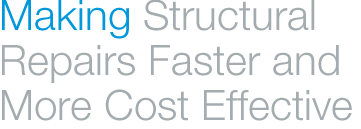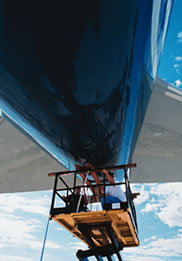

Boeing has developed a new process that has shown dramatic reductions in the time required for Boeing to develop and publish updates to structural repair manuals (SRMs) for the 737-300/-400/-500 and the 747-400. Based on promising results from these initial two airplane models used in the pilot program, Boeing is expanding the use of the approach to other models.
By Partha Mukhopadhyay, Technical Integration Manager, Customer Support Engineering
A new approach to developing and publishing updates to SRMs shows the potential to provide operators with approved repairs more quickly.
The large fleet of Boeing airplanes in service experiences structural damage for multiple reasons, such as hail and storm debris striking the airplane, normal wear and tear, and damage incurred by contact with ground equipment. Thousands of custom repair requests are engineered by Boeing every year, and the cost of such custom work is high for both operators and Boeing.
One way to reduce custom work is to add new standard repairs to SRMs as quickly as possible so that they are easily accessible to all operators. However, traditionally SRM revisions take a long time to develop and publish because of the large number of steps involved in the process.
In a recent pilot program, a new process developed by Boeing has demonstrated the potential to dramatically reduce flow times. Reductions of up to 90 percent were seen in pilot study samples. By reducing this process flow time, operators were able to receive approved standard structural repair data much sooner.
This article describes the new SRM process and how it will benefit operators.
Increased demand for structural repair data
During a recent 15-year period, Boeing has seen a significant increase in demand for approved structural repair data requests from operators and now receives thousands of requests for repairs annually (see fig. 1).
Figure 1: Requests for approved structural repair data
The number of requests for approved repair data has increased nearly sixfold since 1992.

In response to this demand, Boeing is taking a proactive step to provide repair solutions ahead of time. Operators have the opportunity to participate in the process so that in the future they can use standard repairs rather than requesting custom repairs from Boeing.
When an operator identifies structural damage to an airplane that is not covered by a standard published repair in the SRM, they send a request to Boeing for a repair method. The request goes to an engineer who specializes in the area of the airplane that is damaged, who then develops a repair that meets U.S. Federal Aviation Administration (FAA) regulations. The operator accomplishes this custom repair and submits documentation of the repair as accomplished. These documents are examined and, if found compliant with FAA regulations, an FAA authorized representative (AR) approves the repair and the operator receives a signed FAA Form 8100-9. Each repair is designed for a specific airplane and cannot be used for another airplane.
If the same repair condition is found on multiple airplanes, Boeing develops a common repair that can be used successfully on any airplane of that type. The repair is then approved by the FAA AR and added to that airplane model’s SRM, eliminating the need for an operator to contact Boeing for repair information. By using a standard repair in the SRM, the operator saves on engineering research time and the time needed to communicate with Boeing to request a custom repair, thereby completing repairs in a shorter time.
Due to the complexity of developing these types of approved repairs and the number of steps involved in the process, adding a new repair to the SRM could take more than a year. Realizing operators could benefit from getting this information faster, Boeing committed to improving the SRM revision process.
The result is a new collaborative process in which Boeing SRM engineers and stress engineers are physically co-located in a work cell and work together on developing repairs, eliminating transfer and queuing steps in the process. Each work cell is assigned an AR and a specific structural repair project. The work cell remains dedicated to the project until final approval. By utilizing Lean principles, the new process significantly reduces the time required for a new repair to be added to an SRM.
The SRM pilot program was based on a limited set of projects on two airplane models, the 737-300/-400/-500 and the 747-400. The success of the SRM pilot program has led Boeing to implement it on additional airplane models. The time savings that will be achieved when the program is fully rolled out and implemented on additional models are yet to be determined.
Benefits to Operators
Operators will realize several specific benefits with the new process including:
- Increased coverage of repairs in the SRM.
- The time taken to coordinate between operator, manufacturer, and regulatory agency is reduced.
- Airplane downtime reduction.
- Cost reduction.
What operators can do
Selecting the appropriate repair areas for development and incorporation into the SRMs is a team effort between operators and Boeing. Operators can improve the process by sharing information about areas of concern with Boeing so that Boeing can address the areas of need with published repairs. Boeing recommends that operators provide input about structural damage and locations requiring SRM coverage in IdeaXchange on the Web portal MyBoeingFleet.com.
In addition, by being aware of the increased supply of published standard repairs in the SRM, operators are encouraged to check the SRM for solutions during heavy maintenance prior to contacting Boeing.
Summary
A new streamlined approach to developing and publishing updates to SRMs shows the potential to provide operators with approved repairs more quickly. This can save operators time by providing them with the repair they need without making additional requests to Boeing. Boeing will be expanding the new process from the two airplane models used in the pilot to additional in-production models.
For more information, please contact Customer Support Engineering.

